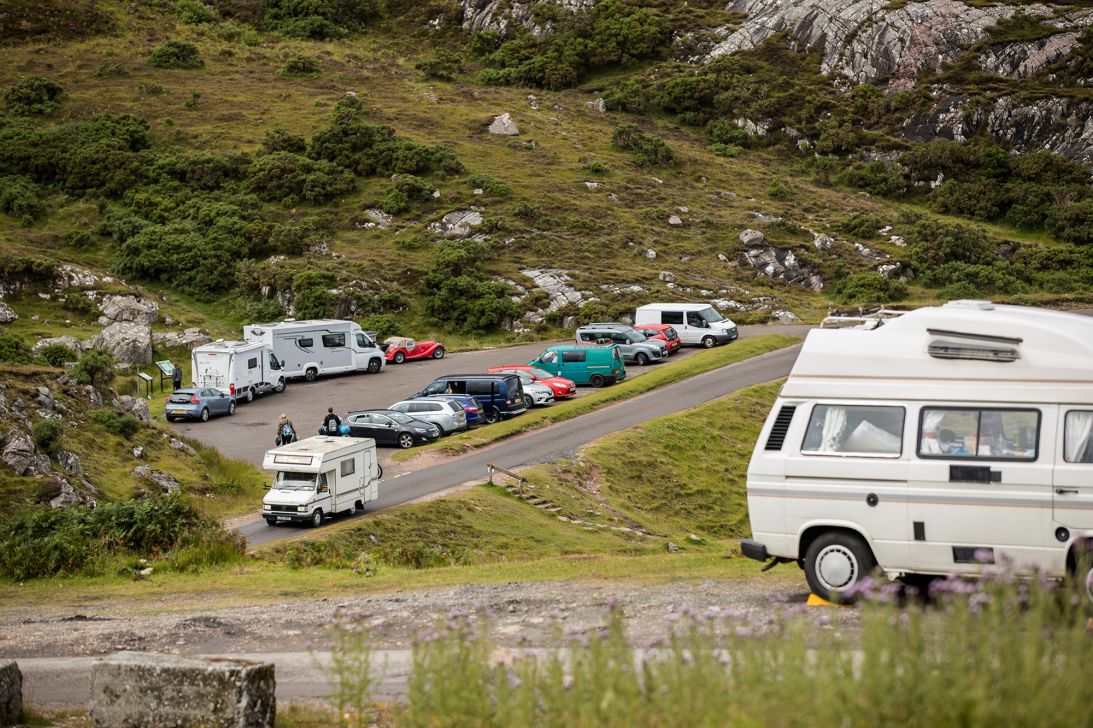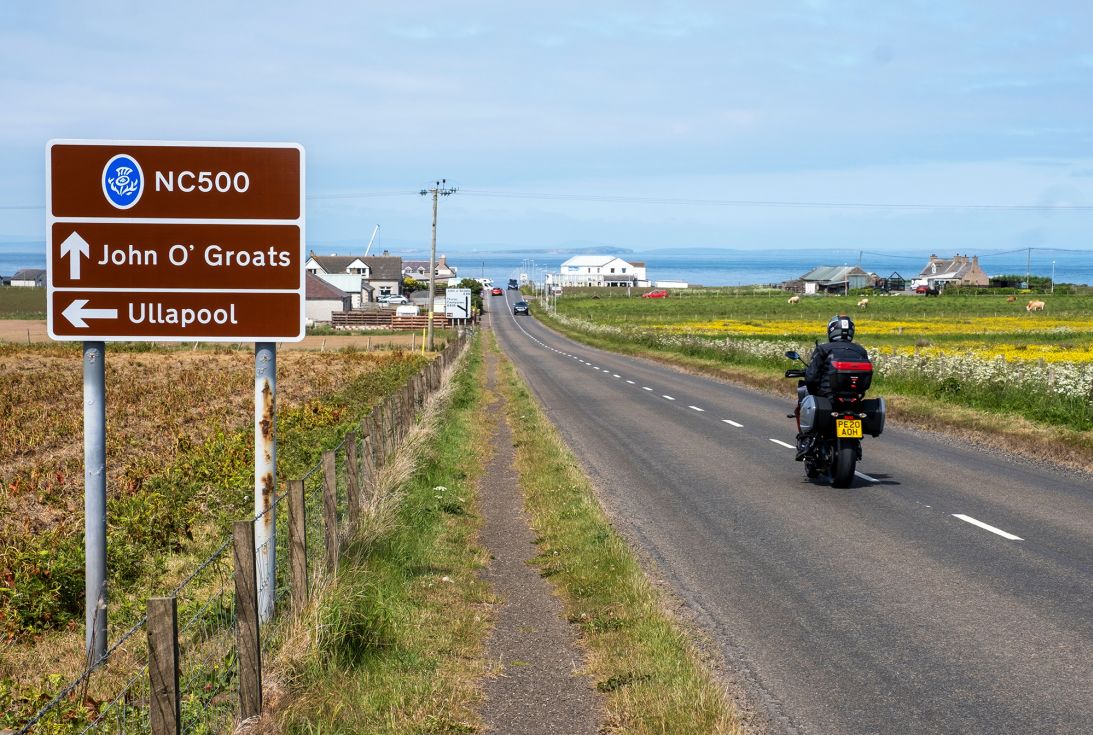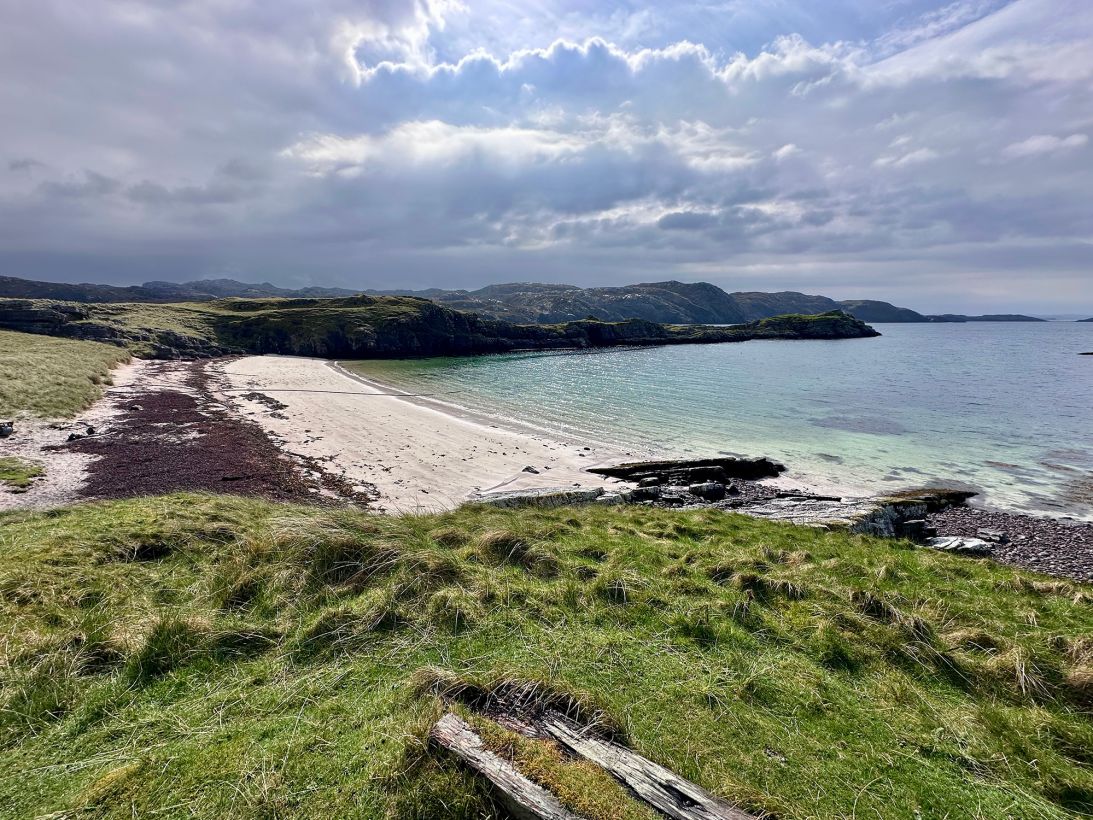Sign up for Unlocking the World, CNN Travel’s weekly newsletter. Get news about destinations, plus the latest in aviation, food and drink, and where to stay.
This past spring, when I pointed my car out of Inverness to begin a loop around Scotland’s craggy northern shoreline, I was expecting trouble ahead. A decade ago, when the North Highland Initiative — a development charity set up under then-Prince Charles — renamed the circuit the North Coast 500 and started promoting the drive to tourists, I had been unconvinced it would work. I approved of any initiative aimed at drawing more visitors to a neglected part of my homeland, but recasting the ramshackle roads of the North Highlands as a desirable destination seemed like a stretch.
Back then, the thought of the drive evoked memories from half a century before — of me and my nauseated siblings squashed inside a rusty Ford station wagon as it rolled through mile after mile of monotonous moorland. Also dampening my enthusiasm were recollections of the food endured in my 20s when introducing my girlfriend of the time to the region. She came up from England expecting langoustines leaping out of creels and venison from stags gralloched, or disembowelled, where they fell on a nearby bed of purple heather. More often than not, in the late 1980s and early 1990s, she had to settle for deep-fried scampi and frozen peas, garnished with a smear of tartare sauce squeezed from a plastic sachet.
Yet the idea of making these overfamiliar highways and hostelries the theater for epic road trips worked. As a promotional move, the North Coast 500 was a masterstroke — too much of one, by most accounts. Thanks to the alchemy of marketing and social media, the 516-mile (830-kilometer) circuit, which starts and finishes in Inverness, became an irresistible, Instagram-friendly pilgrimage for people around the world, overwhelming the ability of the aging and underpopulated region, and its roads, to handle the pilgrims.
Locals began losing patience with what happened next: Nose-to-tail motorhomes on single-track roads, grill dads scorching seafront meadows with disposable barbecues, everywhere becoming an open-air toilet. A decade after its launch, the NC500 is now seen as a textbook case of overtourism. At the end of last year, Fodor’s Travel added the NC500 to its 2025 “No List” of destinations it recommends avoiding, on the grounds that the route’s popularity had made it a threat to the natural environment and a “nuisance” to roadside communities.
But has it all been bad? When I drove the route, primed for a visit to a tourism-ravaged landscape, what I discovered was as much a case for the defense of the much-maligned road trip as an indictment of its negative impact.

No tarmac was melted in the making of the digital phenomenon of the NC500. The roads are hardly any better under their new name than they were in the decades before the North Highland Initiative came up with the idea of marketing them as a destination, or a challenge, in themselves.
Even so, the rechristened route captured the imagination of travel writers and visitor numbers soon began to rise. Everyone seemed to heap praise on the route. No one mentioned the annoying swarms of tiny biting midges that plague Scotland’s west coast in the summer.
As the positive publicity snowballed through the years, I began to find myself lured by thoughts of revisiting places with names as romantically resonant as Durness, Ullapool and Applecross. The Covid pandemic intervened before I had the opportunity to live out that daydream and by the time Britain had emerged from lockdowns, the image of the NC500 had changed.
The founders imagined showcasing a Scotland of sea eagles soaring above secret coves and singing sands. When they envisioned sights that would linger for a lifetime in the mind’s eye, they didn’t have in mind little pagodas of soiled wet wipes used to cover the toilet tracks of wild campers caught short miles from the nearest public restrooms.

When Richard and Jane Alcorn moved seven years ago to Thurso, near the northeastern tip of Scotland’s mainland, to open a bed and breakfast, being close to the NC500 was part of why they chose the location. That decision has been rewarded with steady growth in visitors to their cosy Aurora B&B, but Richard says he understands why some of his fellow residents have come to resent the route.
“Initially the idea was for people to come in their cars, stay in local accommodation, buy from local restaurants and use local facilities. It was an admirable idea and we have seen the benefit of that,” he said. “What you’ve seen since the second lockdown is people trying to have a freebie holiday. More and more caravans and camper vans, people parking up in lay-bys and trying to do it on the cheap. You can see why people get upset with camper vans parking in front of their living room windows, and then there’s the abuse they get when they ask them to move on.”
Thousands of people signed up to Facebook pages dedicated to chronicling such bad behavior. A backlash gathered momentum. As did misgivings about the NC500 brand passing from royal patronage to private ownership: Since 2018, North Coast 500 Ltd has been under the control of Anders Holch Povlsen, a Danish billionaire and Scotland’s biggest landowner.
I was wondering about this as an old school friend and I set off on a drizzly Sunday in late April. Our first stop was Dingwall, a small town located in rich farming land to the north of Inverness that I remember from my childhood as the well-manicured home of a late aunt and uncle.
Lunch options were sparse and, on the High Street, the boarded-up shell of the semi-derelict Commercial Bar was an eyesore reminder that the town has known better times since it was founded as a Royal Burgh authorized by the Scottish Crown precisely 999 years ago. A bit of overtourism might not be the worst thing that could happen here, I thought, not for the last time on our trip.

For the first two-thirds of our journey, we squinted at the views through a misted-up windscreen and wipers on full swipe, failing to spot any evidence of tourists making a nuisance of themselves. There were plenty of camper vans on the roads, but it appeared to be too early in the season for the traffic jams and blocked ambulances the Facebook sites had primed me to expect. Over four days, the only time we got stuck behind a slow-moving vehicle, the culprit was the clearly lost driver of a superstore home-delivery van.
Tourism can be an easy scapegoat for problems it didn’t create and cannot be expected to fix, I thought as we turned into the Old School restaurant and rooms on the banks of the fjord-like Loch Inchard on the North West Sutherland coast. Like many of the establishments on the NC500, this place has been geared to turning around most of its six bedrooms almost every day. Guests are encouraged to check in between 4 p.m. and 6 p.m., eat dinner between 6 p.m. and 8 p.m., breakfast by 9 the following morning and be gone by 10 a.m.
The model can make it feel like “regimented and rushed” has succeeded “rough and ready” as the go-to descriptor for Highland hospitality. But any fears I had were dispelled by a few glasses of red wine and a stew of locally shot venison of the kind my girlfriend and I could only dream of back in the day.

In the morning, the Old School’s owner, Lisa MacLeod, shared her thoughts on the impact of the NC500, starting with an aspect of tourism that sometimes gets forgotten in the costs/benefits debate — the pleasure it has brought to those who might never have visited without it, and the sense of pride and satisfaction that offers to hosts.
“Obviously there are negative parts to it, but generally all these people get to see this most amazing part of the world that they probably wouldn’t have known about otherwise,” she said.
While the NC500 has been good for her seasonal business, MacLeod says it was always unrealistic to expect tourism alone to fix big issues such as the tendency of young people to leave the area for opportunities — or just the excitement — on offer elsewhere. “The majority of people who live here either work offshore in the oil industry, or on the fish farms which bring a lot of young families in,” MacLeod said. “The hotels and the B&Bs are not really what makes the money.”

After a traditional Scottish fried breakfast, we set off to spot puffins, skuas and razorbills on Handa Island, where the sun appeared for the first time on our trip, splitting the clouds to light up the wildlife reserve’s lovely bays in azure hues more usually associated with the Caribbean.
By the time we rolled into the nearby coastal village of Scourie a few hours later, it was properly warm and we were ravenous. Which was well timed because here, at the bottom of one of the steep slender smallholdings, known as crofts, that run down to the bay is the kind of all-day Scottish dining venue I’d been fantasising about for decades.
As we walk up to Grant and Heather Mercer’s Crofters Kitchen food truck there is a hum of quiet contentment from the surrounding picnic tables and the sight of Heather updating the daily-changing specials blackboard is equally reassuring. Grant, a 33-year-old with 17 years of experience under his head chef’s hat, has just taken delivery of some wild halibut from a local fisherman and, hours after it was landed, it is going straight on the menu.
It is just the kind of thing this veteran of Scotland’s long-hours hospitality culture envisaged himself doing when he and Heather first decided to embark on this business venture. Their goal was to spend more time together as a family, while taking advantage of the demand generated by the NC500’s success to serve up the kind of locally sourced, seasonal fare that remains the exception rather than the rule in these parts.
The halibut, grilled to moist, flaky perfection and served with orzo pasta in a wild garlic pesto, is one of the nicest things I’ve ever eaten in Scotland. How long I’d waited for this! As we ate, the Mercers’ 15-month old son was toddling about. With his blond hair, he reminded me of my oldest boy at that age. My son’s mother, the girlfriend with the aversion to scampi suppers, died suddenly 20 years ago, and I felt a stab of sadness that she was not here to enjoy the scene.

Like the NC500, the Crofter’s Kitchen was celebrating an anniversary. It’s one year since it opened and the Mercers have been basking in five-star reviews while planning the next stage of their field-to-fork adventure — using a government business grant to convert a shipping container into indoor seating to serve food all year round, bringing more tourism revenue into the local community.
“As well as sourcing all the seafood locally, we produce a lot of our own vegetables and we also buy salads from other crofters, pork, and venison that’s been shot on their land that I’ll help them butcher,” Grant told me.
“The container will allow us to open almost all year round which will be great for the locals especially in the winter when there is not much open around here. The nearest Chinese takeaway is in Ullapool, a good 45-minute drive away.”
I know from my own experience of living in one of Scotland’s wet and windy corners that infrastructure is not just about parking places and smooth roads. A steady stream of visitors can be the difference between a local store with barely filled shelves and one laden with unexpected choices. As Grant Mercer points out, every halibut delivered by hand to the Crofter’s Kitchen is a fish that is not being loaded onto a truck for export — an economic pivot that balances the impact of the NC500’s tourists against the environmental costs of the region’s participation in a globalized fishing industry.

Heading in a counterclockwise direction, as we did, the road south of Scourie is where the route is at its most breathtaking.
Long before anyone had thought of the NC500 concept, the mountains of Assynt and the Applecross peninsula were a favoured destination for clubs of classic car owners. It was easy to understand why as we glided towards our final overnight stop on meandering corniches lined by banks of sun-drenched flowering gorse. James Bond’s Aston Martin would be a good fit for the timeless elegance of these vistas but even in my slightly bashed Volvo, I had the pleasant feeling that I might be starring in a commercial for a posh watch brand.
These sections of the route are endowed with such beautiful natural assets, it made me reflect on how the NC500 concept has also helped entice visitors to neighboring areas less blessed in the looks department. I also wondered why they were not inundated with tourists and the associated pressures decades ago — had they been, perhaps the infrastructure now coming under strain might already have been upgraded.
Precise data on the economic impact of the NC500 is hard to pin down and often contested, but most analysts agree that the route has helped boost visitor numbers in the broader Highland region (up from 5.1 million in 2012 to 8.4 million in 2023, according to the local council), while tourist spending has grown less quickly (from £1.38 billion to £1.68 billion in the same period.).
VisitScotland, the national tourism body, says the NC500 has undeniably raised the region’s international profile and drawn in extra visitors to the benefit of the local economy.
“The global attention of the route has created some challenges, and we know there is a careful balance to strike between the benefits that tourism brings and ensuring communities feel comfortable and capable of welcoming visitors,” a spokesman said, highlighting the body’s efforts to spread tourism over the whole year, encourage longer stays and plug infrastructural gaps exposed by increased tourist numbers.
Since 2018, VisitScotland has distributed £20 million, or about $27 million, through a Scottish government fund to develop rural tourism infrastructure, including many projects around the NC500, like parking, public toilets and motorhome facilities, the spokesman said.

Such efforts have yet to persuade the skeptics that the route’s problems can be mitigated without a reduction in visitors. According to the travel experts at Fodor’s, the impact of NC500-led overtourism is now so severe it is “steadily changing the region’s culture,” while a recent article in the New York Times was headlined: “Should You Drive Scotland’s ‘Ultimate Road Trip?’ Locals Say Maybe Not.”
Our trip left me unpersuaded — especially given that around one in seven of the region’s jobs depend on tourism. Even if it were true that the culture of the Highlands is being re-sculpted by the invisible hand of tourism, would that necessarily be a bad thing?
Our final hotel on the route provided an answer of sorts. It was the only one I’d been able to find in a 30-mile radius offering two single rooms for under $200 a night and my heart sank as we checked in — the hotel’s public bar revealing itself as a grim haven from the brilliant sunshine, where the early evening crowd formed a depressing tableau of Scotland’s public health challenges.
Inspecting my closet-sized room, I clocked the polyester sheets and fraying carpet, but failed to spot that I’d be destined for a dawn wake-up thanks to the absence of proper curtains.
Later on, getting ready for dinner in a nicer spot, we bumped into a former manager of the hotel and fell into good-humoured conversation about the lack of gentrification at his old place of employment.
“It’s a bit of a rough old place,” I said.
“Mmm,” he replied. “You should see it when the fishermen are in.”




